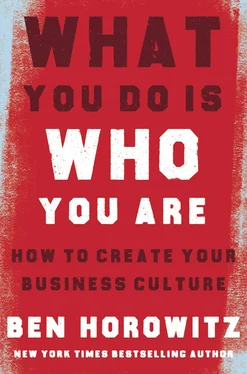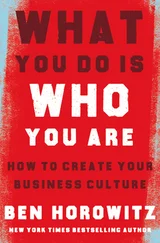To prove “why” himself, Horowitz doesn’t go to the usual well of Fortune 500 winners but to the outer edges of history, where we discover leaders whose stories reveal lessons and insights that are actually core to the creation of culture itself.
In its essence, What You Do Is Who You Are is a book whose content and structure—including the epigraphs Horowitz invokes from the canon of hip-hop legends—perfectly reflect the thesis at work in its pages. It also happens to be an energetic read, with surprising and illuminating applications of the lessons of Louverture, Senghor, and company to the contemporary business and political scene that Horowitz himself, as the former CEO of LoudCloud and cofounder of Andreessen Horowitz, inhabits as one of today’s most uniquely gifted leaders. In this way, Horowitz calls upon a key aspect of the African-American tradition of “signifying”—riffing as a mode of homage, a nod of admiration and respect—and he does so with penetrating insight and memorable effect. The book is also an inspiring nod to an historical tradition that intellectual antecedents such as Arturo Schomburg—caught in the throes of Jim Crow segregated America—sacrificed so much to canonize, hoping that generations hence would see “behind the veil,” as W.E.B. Du Bois put it, to mine lessons for a new, truly cosmopolitan world culture in which they could only dream of flourishing. By centering his transformational volume on culture-makers whose wisdom is found on the margins, Horowitz gives us an instant classic with the potential to redefine “what we do” and, thereby, “who we are.”
INTRODUCTION: WHAT YOU DO IS WHO YOU ARE CONTENTS Cover Title Page WHAT YOU DO IS WHO YOU ARE HOW TO CREATE YOUR BUSINESS CULTURE Ben Horowitz Copyright Dedication Foreword by Henry Louis Gates Jr. Introduction: What You Do Is Who You Are 1 Culture and Revolution: The Story of Toussaint Louverture 2 Toussaint Louverture Applied 3 The Way of the Warrior 4 The Warrior of a Different Way: The Story of Shaka Senghor 5 Shaka Senghor Applied 6 Genghis Khan, Master of Inclusion 7 Inclusion in the Modern World 8 Be Yourself, Design Your Culture 9 Edge Cases and Object Lessons 10 Final Thoughts Author’s Note Index Acknowledgments About the Author Also by Ben Horowitz About the Publisher
Revel in being discarded, or having all your energies exhausted in vain; only those who have endured hardship will be of use. Samurai who have never erred before will never have what it takes.
—Hagakure
When I first founded a company, one called LoudCloud, I sought advice from CEOs and industry leaders. They all told me, “Pay attention to your culture. Culture is the most important thing.”
But when I asked these leaders, “What exactly is culture, and how can I affect mine?” they became extremely vague. I spent the next eighteen years trying to figure this question out. Is culture dogs at work and yoga in the break room? No, those are perks. Is it your corporate values? No, those are aspirations. Is it the personality and priorities of the CEO? That helps shape the culture, but it is far from the thing itself.
When I was the CEO of LoudCloud, I figured that our company culture would be just a reflection of my values, behaviors, and personality. So I focused all my energy on “leading by example.” To my bewilderment and horror, that method did not scale as the company grew and diversified. Our culture became a hodgepodge of different cultures fostered under different managers, and most of these cultures were unintentional. Some managers were screamers who intimidated their people, others neglected to give any feedback, some didn’t bother returning emails—it was a big mess.
I had a middle manager—I’ll call him Thorston—who I thought was pretty good. He worked in marketing and was a great storyteller (an essential marketing skill). I was shocked to find out, from overhearing casual conversations, that he was taking storytelling to another level by constantly lying about everything. Thorston was soon working elsewhere, but I knew I had to deal with a much deeper problem: because it had taken me years to find out that he was a compulsive liar, during which time he’d been promoted, it had become culturally okay to lie at LoudCloud. The object lesson had been learned. It did not matter that I never endorsed it: his getting away with it made it seem okay. How could I undo that lesson and restore our culture? I hadn’t the first clue.
To really understand how this stuff works, I knew I had to dig deeper. So I asked myself, How many of the following questions can be resolved by turning to your corporate goals or mission statement?
Is that phone call so important I need to return it today, or can it wait till tomorrow?
Can I ask for a raise before my annual review?
Is the quality of this document good enough or should I keep working on it?
Do I have to be on time for that meeting?
Should I stay at the Four Seasons or the Red Roof Inn?
When I negotiate this contract, what’s more important: the price or the partnership?
Should I point out what my peers do wrong, or what they do right?
Should I go home at 5 p.m. or 8 p.m.?
How hard do I need to study the competition?
Should we discuss the color of this new product for five minutes or thirty hours?
If I know something is badly broken in the company, should I say something? Whom should I tell?
Is winning more important than ethics?
The answer is zero.
There aren’t any “right answers” to those questions. The right answers for your company depend on what your company is, what it does, and what it wants to be. In fact, how your employees answer these kinds of questions is your culture. Because your culture is how your company makes decisions when you’re not there. It’s the set of assumptions your employees use to resolve the problems they face every day. It’s how they behave when no one is looking. If you don’t methodically set your culture, then two-thirds of it will end up being accidental, and the rest will be a mistake.
So how do you design and shape these nearly invisible behaviors? I asked that of Shaka Senghor, who ran a powerful gang in the Michigan prison system in the 1990s and 2000s. Senghor knew that the lives of his guys depended on the gang’s culture. He told me, “It’s complex. Say someone steals one of your guys’ toothbrushes, what do you do?”
I said, “That seems innocent enough. Maybe the thief just wanted clean teeth?”
He corrected me: “A guy doesn’t take that risk for clean teeth. It’s a diagnostic. If we don’t respond, then he knows he can rob your guy of something larger or rape him or kill him and take over his business. So if I do nothing, I put all our members at risk. Killing the guy would be a big deterrent—but it would also create a superviolent culture.” He spread his hands. “As I said, it’s complex.”
Identifying the culture you want is hard: you have to figure out not only where your company is trying to go, but the road it should take to get there. For many startups, a culture of frugality is vital, so it makes sense to require that employees stay at the Red Roof Inn. But if Google is paying a salesperson $500,000 a year and it wants to retain her, it will probably prefer that she sleep well at the Four Seasons before her big meeting with Procter & Gamble.
Likewise, long days are standard in the startup world—you’re in a race against time. But at Slack, CEO Stewart Butterfield is convinced that if you actually work hard when you are at work, you can efficiently get a lot done. He punches out early and encourages his employees to do the same.
The culture that works for Apple would never work for Amazon. At Apple, generating the most brilliant designs in the world is paramount. To reinforce that message, it spent $5 billion on its sleek new headquarters. At Amazon, Jeff Bezos famously said, “Your fat margins are my opportunity.” To reinforce that message, he made the company be frugal in everything, down to his employees’ ten-dollar desks. Both cultures work. Apple designs dramatically more beautiful products than Amazon, while Amazon’s products are dramatically cheaper than Apple’s.
Читать дальше












